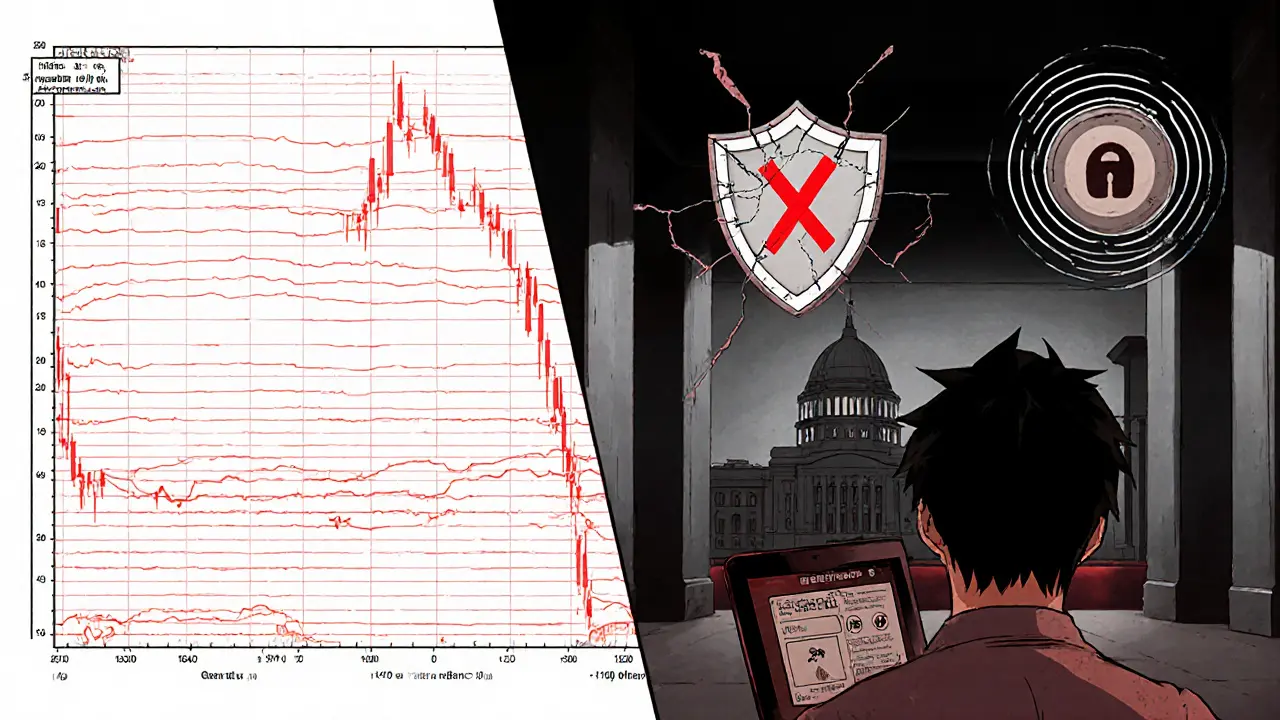Pearl v1.5 Crypto Exchange Risk Assessment Tool
Exchange Overview
This tool helps evaluate the risk level of using Pearl v1.5 based on key criteria important for crypto traders.
Risk Assessment Result
Pearl v1.5 crypto exchange promises zero‑fee trading, but does it deliver enough safety and features to win traders’ trust? This review breaks down the platform’s fee model, traffic numbers, security posture, and how it stacks up against the heavyweights.
What is Pearl v1.5?
Founded in 2023, Pearl v1.5 is a cryptocurrency exchange that markets itself as a zero‑fee trading venue for retail and institutional users. The service lives at pearl.exchange and claims to support a limited set of major coins, though public documentation is sparse.
Zero‑Fee Trading - The Main Hook
The platform’s headline feature is a 0.00% maker and taker fee structure. In contrast, most established exchanges charge 0.25%‑0.40% for takers and offer maker fees ranging from 0% to 0.25%. While a zero‑fee model sounds attractive, it raises two practical questions:
- How does Pearl v1.5 make money? (Potential hidden spreads or withdrawal fees.)
- Does the lack of fees compensate for its other shortcomings?
For traders whose strategy depends on high‑volume, low‑margin trades, the fee savings can be significant-provided the exchange is liquid and secure.
User Adoption & Traffic
Traffic data tells a stark story. Pearl v1.5 records only about 60 organic monthly visits with a 36% bounce rate and an average session length of essentially zero seconds. In the cryptocurrency exchange ranking, it sits 509 out of 612, indicating very low market penetration.
Low traffic can mean two things:
- Fresh platform still building a user base.
- Insufficient liquidity and limited order‑book depth, which can cause slippage for even modest trades.
Unlike crowded venues such as Binance the world’s largest crypto exchange by volume, offering over 600 trading pairs and deep liquidity, Pearl v1.5’s thin market makes price discovery uncertain.
Regulatory Compliance - A Critical Gap
Regulatory oversight is a cornerstone of user protection. At the time of writing, Pearl v1.5 regulatory compliance does not appear to be licensed or supervised by any financial authority. This contrasts sharply with platforms like Coinbase a publicly traded U.S. exchange that holds multiple state and federal licenses and follows stringent AML/KYC standards or Kraken which operates under licenses in the U.S., EU, and Japan, offering audited cold storage and robust security controls.
Without a regulatory framework, users have limited recourse if the platform experiences insolvency, hacking, or fraud.

Security Measures
Security details for Pearl v1.5 are vague. The site mentions two‑factor authentication (2FA), but there is no public audit report, no disclosed cold‑storage ratio, and no insurance coverage. By comparison:
- Kraken stores roughly 95% of user funds offline and undergoes regular third‑party security audits.
- Coinbase offers $250million in insurance for digital assets held in hot wallets and follows a comprehensive security roadmap.
The lack of transparent security practices makes it hard to gauge risk.
Feature Set Comparison
| Feature | Pearl v1.5 | Kraken | Coinbase | Uphold | Gemini |
|---|---|---|---|---|---|
| Trading fees | 0.00% maker / 0.00% taker | 0.00%‑0.26% maker, 0.16%‑0.26% taker | 0.00%‑0.50% depending on volume | 0.20%‑2.95% (varies by asset) | 0.03%‑3.49% (varies by method) |
| Number of crypto pairs | ~10 major coins | 466+ | 250+ | 300+ | 200+ |
| Regulatory licensing | None reported | US, EU, Japan licenses | US state & federal licenses | US & EU licenses | US & EU licenses |
| Security (cold storage %) | Undisclosed | ≈95% offline | ≈98% offline | ≈90% offline | ≈95% offline |
| Customer support | Limited email only | 24/7 live chat & phone | Phone, chat, email | Email & chat | Phone, chat, email |
| Mobile app | No native app (web‑only) | iOS & Android | iOS & Android | iOS & Android | iOS & Android |
Pros & Cons
Summarizing the data gives a clearer picture of where Pearl v1.5 shines and where it falls short.
- Pros
- Zero‑fee trading eliminates direct transaction costs.
- Simple web interface - no app bloat.
- Potentially attractive for hobbyists testing small amounts.
- Cons
- Extremely low traffic translates to limited liquidity.
- No recognized regulatory licensure - high custodial risk.
- Security details are vague; no public audits or insurance.
- Feature set lags behind rivals - no margin, futures, staking, or robust mobile app.
- Community support is practically nonexistent.
Who Might Consider Pearl v1.5?
If you’re a trader who exclusively moves tiny amounts (under $500) and values a fee‑free experience above all else, Pearl v1.5 could serve as a sandbox. However, anyone holding larger balances, seeking deep liquidity, or needing regulatory safeguards should look elsewhere.
Final Verdict
Zero‑fee trading is a bold promise, but it can’t compensate for the platform’s lack of users, regulatory oversight, and transparent security. Compared with industry giants-Kraken, Coinbase, Uphold, and Gemini-Pearl v1.5 looks more like a curiosity than a reliable trading venue. For most traders, the safer path is to stick with a licensed, liquid exchange, even if that means paying a modest fee.

Frequently Asked Questions
Is Pearl v1.5 safe to store my crypto?
Safety is uncertain. The exchange does not disclose cold‑storage ratios, has no public audits, and lacks regulatory licensing. Users should only keep minimal amounts on the platform.
How does Pearl v1.5 make money if trading is free?
The site does not reveal its revenue model. Possibilities include spread markup on price feeds, fees on withdrawals, or premium services that are not advertised.
Does Pearl v1.5 support margin or futures trading?
No. The platform currently offers only spot trading for a limited list of major cryptocurrencies.
Can I link my bank account to Pearl v1.5 for deposits?
Deposit methods are not clearly documented. Existing users report only crypto‑to‑crypto deposits; fiat on‑ramps appear unavailable.
Is there a mobile app for Pearl v1.5?
No native iOS or Android app exists. Trading is limited to the responsive web interface.


14 Responses
Zero‑fee trading sounds enticing, but the lack of liquidity on Pearl v1.5 is a glaring downside. With only about 60 monthly visitors, slippage is a real risk even for modest trades. The platform also provides no regulatory licence, which means users have little recourse if anything goes wrong. While the web‑only interface is clean, the vague security details make me uneasy. Overall, I’d give it a cautious rating and suggest keeping any holdings there to a minimum.
One might argue that a zero‑fee model is inherently revolutionary, yet we must interrogate the economics that sustain such a promise; without transparent revenue streams, the exchange may be subsidising users in ways that are not immediately apparent. Consider the opportunity cost of low liquidity: a thin order book can amplify price impact, turning a seemingly harmless trade into a costly mistake, especially when market depth is shallow. Moreover, the absence of any documented regulatory oversight places the custodial risk squarely on the user’s shoulders, a circumstance that should not be dismissed lightly. Security, too, remains shrouded in ambiguity-no public audits, no disclosed cold‑storage ratios, and no insurance coverage have been presented, which is disconcerting for any prudent investor. The platform’s traffic metrics-approximately 60 organic monthly visits-underscore a minimal user base, suggesting that community support and peer verification are virtually nonexistent. Such scarcity can also hinder the discovery of arbitrage opportunities, as price discrepancies may persist longer without a critical mass of participants. While the interface is straightforward and the zero‑fee structure eliminates explicit transaction costs, it is plausible that the exchange recoups revenue through hidden spreads, withdrawal fees, or premium services that are not overtly advertised. In essence, the apparent cost savings may be an illusion, masking underlying expenses that manifest in less obvious ways. From a risk management perspective, allocating sizeable capital to a platform with these characteristics is imprudent; a more diversified approach across regulated, high‑liquidity venues would better safeguard assets. Additionally, the lack of a mobile application restricts accessibility, thereby limiting the convenience factor that many traders now consider essential. The limited asset list-circa ten major coins-further constrains portfolio diversification, compelling users to seek alternative venues for broader exposure. Regulatory compliance, or the lack thereof, is not merely a bureaucratic hurdle; it often correlates with mandatory security standards, AML/KYC procedures, and consumer protection mechanisms that are vital in the volatile crypto ecosystem. If one were to ignore these red flags, the rational expectation would be that the user bears the brunt of any adverse events, ranging from insolvency to cyber‑theft. Hence, the zero‑fee allure must be weighed against the substantive risks outlined above. Ultimately, while Pearl v1.5 may serve as an experimental sandbox for token‑sized trades, it should not be the cornerstone of a serious investment strategy.
Zero fees? Great, if you don’t mind watching your order slip like a wet floor sign on a deserted dance floor. Without liquidity or regulation, the “free” part feels more like a price tag you can’t see.
Even a tiny trade can get eaten by slippage on such a thin market, so keep amounts low. It’s better to test the UI with a few dollars than risk a big loss.
Zero‑fees? Or zero‑trust, whichever comes first.
Starting small is a wise move; it lets you gauge execution speed without exposing large capital. If you notice any unexpected spreads, consider pulling out before the platform scales up. Remember, protecting your principal is always the first priority.
I get why the zero‑fee hook is tempting, but the lack of clear security feels risky. Stick to what you’re comfortable with and don’t put more than you can afford to lose.
Honestly, the platform jus looks like a beta project, its fluxy UI and missing mobile app dont help. Its limited coin list is defi nitely a drawback, but some peope might still find it usefull for a quick test. If you do try it, be ready for possible hiccups and dont expect top tier support.
Hey, just a heads‑up: if you’re planning to move more than a few hundred dollars, you’ll probably hit slippage fast. The lack of a licence means you’re on your own if anything goes south, so keep that in mind.
Looks like a fun sandbox for tiny trades 😊, but don’t forget the hidden costs could bite later 😅.
They say it’s zero‑fee, but you never see the fine print where they might be padding spreads behind the scenes. And without any regulator watching, who’s to stop them from disappearing with your assets? It feels like a perfect storm for a shady operation.
The promise of free trading shines like a lighthouse in a foggy sea, yet the rocks below-no licence, thin liquidity-remain unseen. One can admire the ambition, but caution must anchor the heart.
Zero fees sound like a dream, but dreaming without a cushion of security is risky. If you’re itching to try, start with pennies, watch the order book, and only scale up when the platform proves it won’t vanish. Keep the enthusiasm, but pair it with a healthy dose of skepticism.
When evaluating a nascent exchange such as Pearl v1.5, one must first confront the stark reality of its user base: a modest tally of roughly sixty monthly visitors, a figure that scarcely scratches the surface of a thriving market. This paucity of traffic translates directly into limited depth, meaning that even modest orders can shift the market price dramatically, a condition that seasoned traders recognize as slippage. Moreover, the platform’s ostensible zero‑fee structure begs the question of hidden revenue mechanisms; without disclosed spreads or explicit fee schedules, one can only infer that the exchange profits via indirect channels, perhaps widening the bid‑ask spread or imposing covert withdrawal charges. The regulatory vacuum is equally concerning: the absence of any licensing authority implies that, should the exchange encounter insolvency, users have scant legal recourse, a risk amplified by the dearth of custodial insurance coverage. Security, too, remains enveloped in opacity-no public audit reports, no disclosed cold‑storage percentages, and no third‑party attestations leave the user in a state of perpetual uncertainty. From a risk‑adjusted perspective, allocating capital to such an operation is tantamount to placing a bet on an untested horse in a race where the rules are undefined. While the interface is sleek and the allure of fee‑free trading is potent, the practicalities of execution-especially for assets requiring swift entry and exit-are hampered by thin order books and potential latency. In addition, the platform’s limited asset offering, circumscribed to roughly ten major cryptocurrencies, restricts diversification strategies and forces traders to seek alternative venues for broader exposure. The lack of a native mobile application further narrows accessibility, confining participants to a desktop environment that may not suit all trading styles. Consequently, the prudent approach for most investors is to treat Pearl v1.5 as an experimental sandbox for negligible amounts, rather than a cornerstone of a serious portfolio. Should you decide to engage, do so with capital you can afford to lose, monitor transaction outcomes meticulously, and maintain a contingency plan to exit swiftly if red flags emerge. In sum, the exchange’s innovative fee model cannot compensate for the substantive deficiencies in liquidity, regulation, and security that underlie its operation. Investors who prioritize compliance should favor exchanges registered with recognized authorities, as these entities are subject to periodic audits and consumer protection mandates. Additionally, community forums and independent reviews often surface hidden issues that a corporate website may gloss over; a cursory search reveals mixed experiences with Pearl v1.5. Therefore, due diligence extends beyond the official site-dig into user testimonies, examine blockchain transaction logs, and assess the plausibility of the exchange’s business model. Only through such comprehensive scrutiny can one make an informed decision about participating in this high‑risk environment.